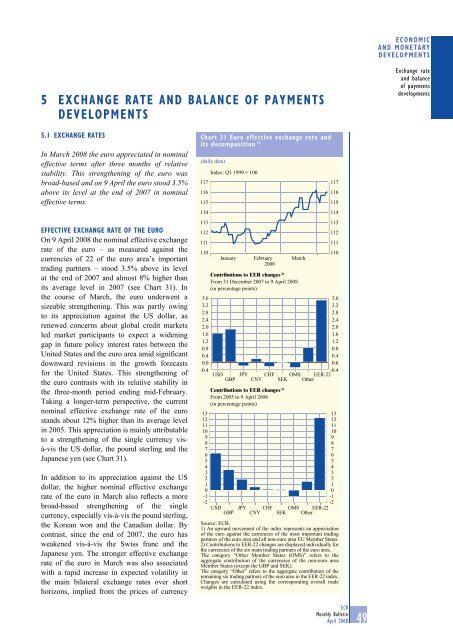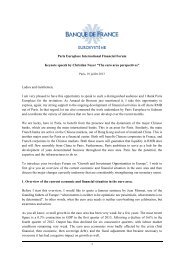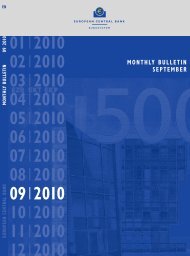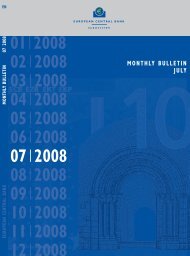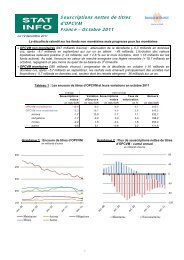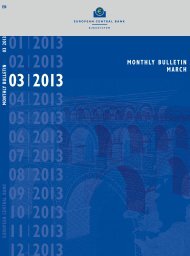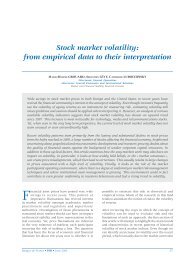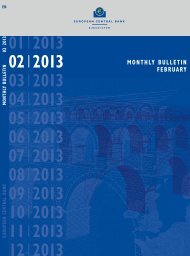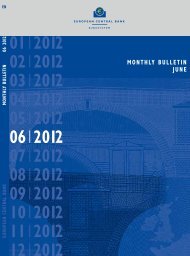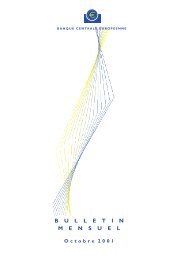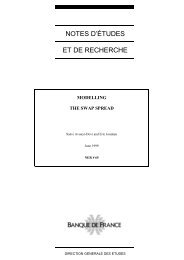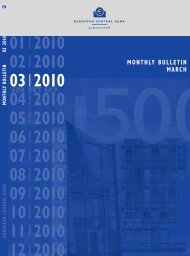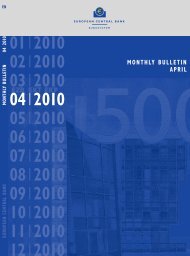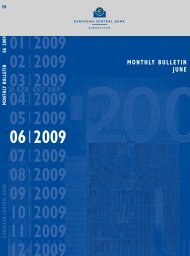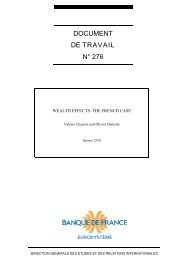Monthly Bulletin April 2008 - European Central Bank - Europa
Monthly Bulletin April 2008 - European Central Bank - Europa
Monthly Bulletin April 2008 - European Central Bank - Europa
Create successful ePaper yourself
Turn your PDF publications into a flip-book with our unique Google optimized e-Paper software.
ECONOMIC<br />
AND MONETARY<br />
DEVELOPMENTS<br />
5 EXCHANGE RATE AND BALANCE OF PAYMENTS<br />
DEVELOPMENTS<br />
Exchange rate<br />
and balance<br />
of payments<br />
developments<br />
5.1 EXCHANGE RATES<br />
In March <strong>2008</strong> the euro appreciated in nominal<br />
effective terms after three months of relative<br />
stability. This strengthening of the euro was<br />
broad-based and on 9 <strong>April</strong> the euro stood 3.5%<br />
above its level at the end of 2007 in nominal<br />
effective terms.<br />
EFFECTIVE EXCHANGE RATE OF THE EURO<br />
On 9 <strong>April</strong> <strong>2008</strong> the nominal effective exchange<br />
rate of the euro – as measured against the<br />
currencies of 22 of the euro area’s important<br />
trading partners – stood 3.5% above its level<br />
at the end of 2007 and almost 8% higher than<br />
its average level in 2007 (see Chart 31). In<br />
the course of March, the euro underwent a<br />
sizeable strengthening. This was partly owing<br />
to its appreciation against the US dollar, as<br />
renewed concerns about global credit markets<br />
led market participants to expect a widening<br />
gap in future policy interest rates between the<br />
United States and the euro area amid significant<br />
downward revisions in the growth forecasts<br />
for the United States. This strengthening of<br />
the euro contrasts with its relative stability in<br />
the three-month period ending mid-February.<br />
Taking a longer-term perspective, the current<br />
nominal effective exchange rate of the euro<br />
stands about 12% higher than its average level<br />
in 2005. This appreciation is mainly attributable<br />
to a strengthening of the single currency visà-vis<br />
the US dollar, the pound sterling and the<br />
Japanese yen (see Chart 31).<br />
In addition to its appreciation against the US<br />
dollar, the higher nominal effective exchange<br />
rate of the euro in March also reflects a more<br />
broad-based strengthening of the single<br />
currency, especially vis-à-vis the pound sterling,<br />
the Korean won and the Canadian dollar. By<br />
contrast, since the end of 2007, the euro has<br />
weakened vis-à-vis the Swiss franc and the<br />
Japanese yen. The stronger effective exchange<br />
rate of the euro in March was also associated<br />
with a rapid increase in expected volatility in<br />
the main bilateral exchange rates over short<br />
horizons, implied from the prices of currency<br />
Chart 31 Euro effective exchange rate and<br />
its decomposition 1)<br />
(daily data)<br />
117<br />
116<br />
115<br />
114<br />
113<br />
112<br />
111<br />
110<br />
3.6<br />
3.2<br />
2.8<br />
2.4<br />
2.0<br />
1.6<br />
1.2<br />
0.8<br />
0.4<br />
0.0<br />
-0.4<br />
13<br />
12<br />
11<br />
10<br />
9<br />
8<br />
7<br />
6<br />
5<br />
4<br />
3<br />
2<br />
1<br />
0<br />
-1<br />
-2<br />
Index: Q1 1999 = 100<br />
January<br />
February<br />
<strong>2008</strong><br />
March<br />
Contributions to EER changes 2)<br />
From 31 December 2007 to 9 <strong>April</strong> <strong>2008</strong><br />
(in percentage points)<br />
117<br />
116<br />
115<br />
114<br />
113<br />
112<br />
111<br />
110<br />
3.6<br />
3.2<br />
2.8<br />
2.4<br />
2.0<br />
1.6<br />
1.2<br />
0.8<br />
0.4<br />
0.0<br />
-0.4<br />
USD<br />
GBP<br />
JPY CHF<br />
CNY<br />
OMS EER-22<br />
SEK Other<br />
Contributions to EER changes 2)<br />
From 2005 to 9 <strong>April</strong> <strong>2008</strong><br />
(in percentage points)<br />
13<br />
12<br />
11<br />
10<br />
9<br />
8<br />
7<br />
6<br />
5<br />
4<br />
3<br />
2<br />
1<br />
0<br />
-1<br />
-2<br />
USD JPY CHF OMS EER-22<br />
GBP CNY SEK Other<br />
Source: ECB.<br />
1) An upward movement of the index represents an appreciation<br />
of the euro against the currencies of the most important trading<br />
partners of the euro area and all non-euro area EU Member States.<br />
2) Contributions to EER-22 changes are displayed individually for<br />
the currencies of the six main trading partners of the euro area.<br />
The category “Other Member States (OMS)” refers to the<br />
aggregate contribution of the currencies of the non-euro area<br />
Member States (except the GBP and SEK).<br />
The category “Other” refers to the aggregate contribution of the<br />
remaining six trading partners of the euro area in the EER-22 index.<br />
Changes are calculated using the corresponding overall trade<br />
weights in the EER-22 index.<br />
ECB<br />
<strong>Monthly</strong> <strong>Bulletin</strong><br />
<strong>April</strong> <strong>2008</strong><br />
49


